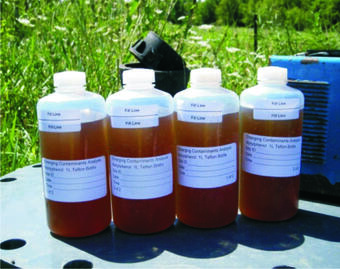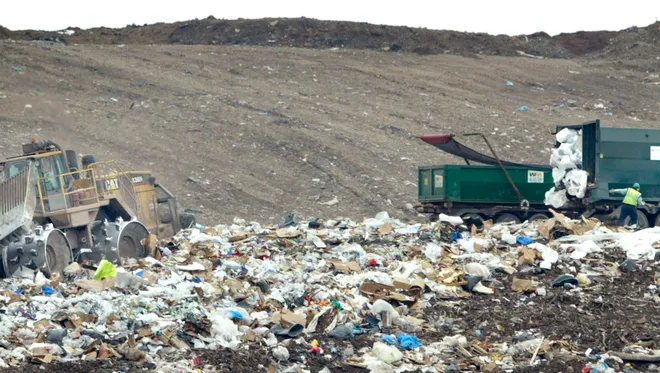Young Harris GA Leachate from Georgia Landfills in Hiwassee River Basin
What is Happening
The city of Young Harris, Georgia has been accepting raw, untreated, leachate from Richland Creek Landfill, in Buford GA since March 16, 2022 into its Water Pollution Control Plant (WPCP) (waste water treatment plant). In recent months, Young Harris has expanded reception of leachate from a second landfill. To date, Young Harris has accepted over 5.5 MILLION gallons of leachate. Effluent from the Young Harris WPCP pours into Brasstown Creek. Brasstown Creek flows northward, and empties into the Hiwassee River, at Brasstown, NC, upstream from the City of Murphy, NC. Lake Hiwassee and Apalachia Lake are fed from the Hiwassee River.
Young Harris’s water treatment plant is operating under expired NPDES Permit # GA002246 for Water Pollution Control Plant. It Expired in March of 2022. GA Environmental Protection Division (EPD) Administratively extended it until it can get around to reviewing the renewal permit. There is no date certain when GA EPD will have time to examine the situation at Young Harris or require additional monitoring and compliance measures.
- There has been only 1 metals test from dozens of leachate deliveries to Young Harris WPCP.
- Young Harris is skating along on an expired, but administratively extended plant permit.
- Testing does not reflect the “significant industrial user” (EPD’s words) load from leachate that Young Harris accepts into its PWCP.
What is leachate?
The United States Geological Survey (USGS) explains it this way in a 2015 publication:
“Landfills are the final repository for a heterogeneous mixture of liquid and solid waste from residential, industrial, and commercial sources, and thus, have the potential to produce leachate—a liquid waste product that consists of a diverse mixture of chemicals as precipitation or applied water moves through the waste. Landfills are often not the final repository for leachate which can be discharged to surface waters following onsite or offsite wastewater treatment.” USGS, 11/2015) Landfill Leachate Released to Wastewater Treatment Plants and other Environmental Pathways Contains a Mixture of Contaminants including Pharmaceuticals
Further:
“In this study, final leachate samples from 22 landfills were collected and analyzed for 190 [Contaminents of Emerging Concern] CECs including pharmaceuticals, industrial chemicals, household chemicals, steroid hormones, and plant/animal sterols. The sampling network included municipal and private landfills with varying landfill waste compositions; geographic and climatic settings; ages of waste, waste loads, and leachate production; and leachate management strategies.
Scientists determined that final leachate samples contained 101 of the 190 chemicals analyzed for the study, with chemicals present in every final leachate sample collected at levels ranging from as low as 2 nanograms per liter (ng/L) to as high as 17,200,000 ng/L. The most frequently detected CECs were lidocaine (local anesthetic, found in 91 percent of samples), cotinine (nicotine breakdown product, 86 percent), carisoprodol (muscle relaxant, 82 percent), bisphenol A (component for plastics and thermal paper, 77 percent), carbamazepine (anticonvulsant, 77 percent), and N,N-diethyltoluamide (DEET, insect repellent, 68 percent).”

Leachate is a nasty, toxic cocktail of organic and inorganic chemicals and compounds, household waste, improperly disposed of petroleum waste, medical waste, paints, solvents grocery store cuttings and waste. Really whatever anyone can toss into an unguarded dumpster or trash can will end up in a landfill, will have rainwater percolate through it in the landfill to produce the leachate brew.
Georgia Environmental Protection Division Permit and Letter.
Young Harris’s Water Pollution Control Permit which expired in March of 22 is here: 2017 NPDES permit for wastewater plant.
Here is the Georgia Environmental Protection Division’s April 28, 2021 letter, NPDES Permit No. GA0022462 – City of Young Harris WPCP – Leachate Acceptance Request allowing leachate dumping at Young Harris.
But, take a close look at GA EPD’s stipulations for that dumping:
“Please note that, in accordance with Section 391-3-6-.08(2)(u)(1) of the Rules for Water Quality Control, an industrial user (i.e., landfill) is considered a significant industrial user and a pre-treatment permit is required prior to discharging to the City’s WPCP, if any of the following thresholds are exceeded:
1. Any industrial user that discharges an average of 25,000 gallons per day or more of process wastewater to the publicly-owned treatment work (POTW), or
2. Any industrial user that contributes a process waste stream which makes up 5 percent or more of the average dry weather hydraulic capacity of the POTW, or
3. Any industrial user that contributes a process waste stream which makes up 5 percent or more of the average dry weather organic capacity of the POTW.
Based on the current permitted flow of 0.24 MGD, it appears that at least one of the above thresholds will be exceeded if the Young Harris WPCP accepts up to 25,000 gal/day of leachate from a landfill.”
Quantity of Leachate at Young Harris
Young Harris WPCP has accepted to date at least 5.5 million gallons of leachate since March 2022, and on average receives over 507,000 gallons per month. The leachate does not undergo an Industrial Pre-Treatment – it is dumped raw into the water treatment plant.
- YH exceeded the GA EPD limit of 25,000 gallons per day for industrial waste in 4 of last 11 months: March, April, May & December of 2022.
- Leachate is contributing well over 5% (12,000 gallons) of the plant’s total permitted flow of 240K gallons per day, 2 times the allowable amount, in 6 of last 11 mo.
Young Harris has been receiving upwards of 5 – 11, 6,000 gallon tankers per delivery day. On some days, the leachate flow, exceeding EPD’s stipulations letter (25KGAL / 5%) would have been extreme. How can the plant effectively treat the leachate, which has not been pre-treated?
| Young Harris Water Treatment Plant Leachate Summary | |||||
| Year | Month | Volume (gallons) | Delivery Days | Gal/Day | Note |
| 2022 | 3 | 412,407.48 | 15 | 27,493.83 | partial month, starting 3/16 |
| 2022 | 4 | 719,094.72 | 21 | 34,242.61 | |
| 2022 | 5 | 722,100.71 | 22 | 32,22.786 | |
| 2022 | 6 | 437,436.45 | 21 | 20,830.31 | |
| 2022 | 7 | 388,350.12 | 21 | 18,492.86 | |
| 2022 | 8 | 529,235.01 | 22 | 24,056.14 | |
| 2022 | 9 | 501,845.32 | 22 | 22,811.15 | |
| 2022 | 10 | 462,980.82 | 21 | 22,046.71 | |
| 2022 | 11 | 523,621.10 | 21 | 24,934.34 | |
| 2022 | 12 | 655,929.26 | 22 | 29,814.97 | |
| 2023 | 1 | 228,146.28 | 17 | 13,420.37 | |
| Total (gallons) | 5,581,147.27 | ||||
| Monthly Avg (gallons) | 507,377.02 | ||||
What You Can Do
- Write a letter to the editor of “The Scout” Make the public and your local and state government aware of what Young Harris, Georgia is sending downstream to North Carolina.
- Contact Young Harris Mayor Gibbey – andreagibby@cityofyoungharris.net
- Contacted Local or NC State Lawmakers:
- Karl Gillespie – 919-733-5859
- Kevin Corbin – 919-733-5875
- Contact NC Department of Environmental Quality, Water Quality Division:
Physical AddressNorth Carolina Department of Environmental Quality


